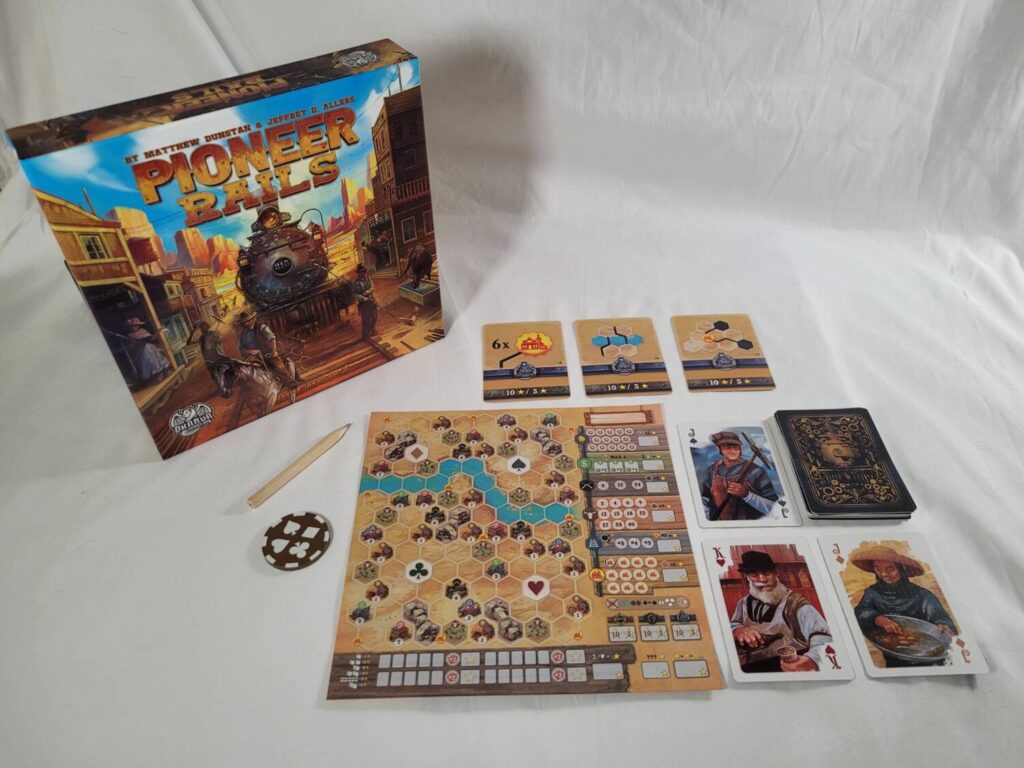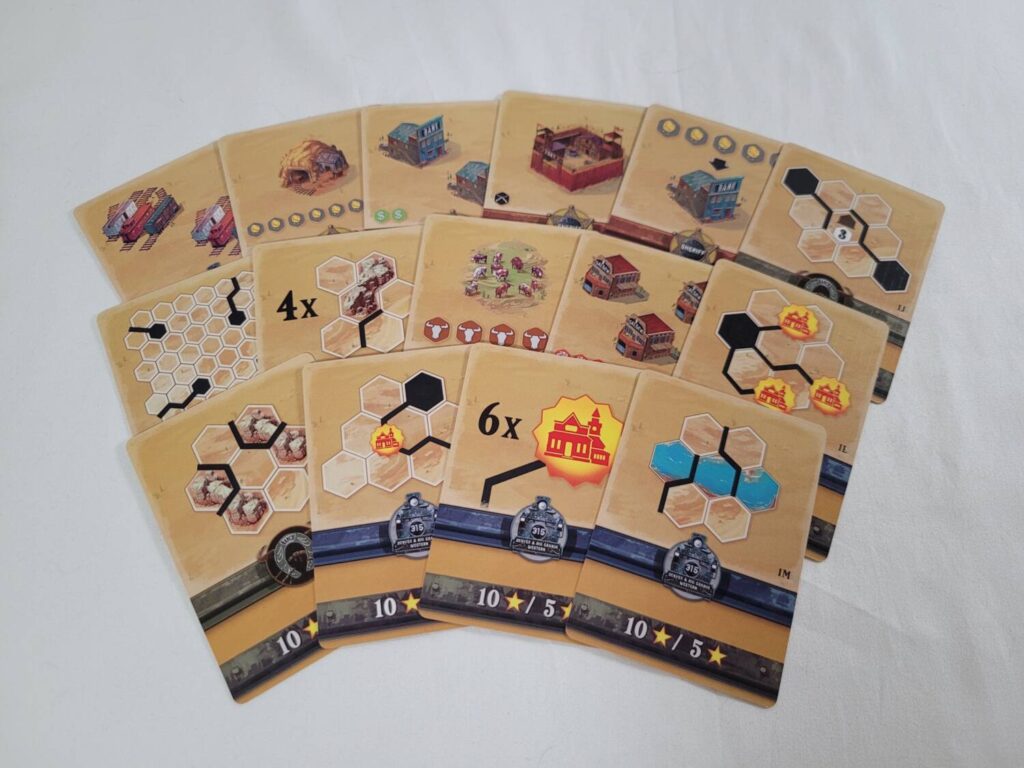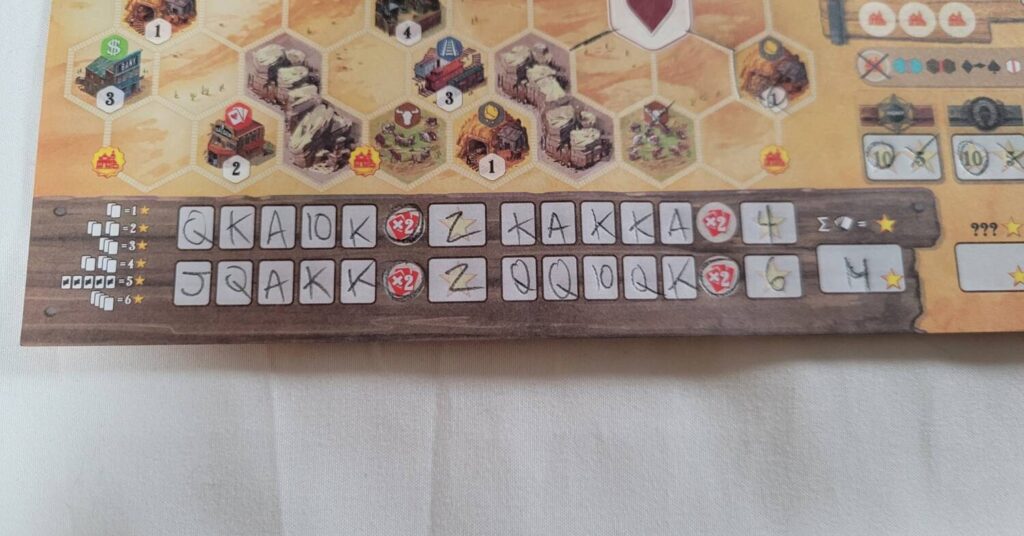Disclosure: Meeple Mountain received a free copy of this product in exchange for an honest, unbiased review. This review is not intended to be an endorsement.
The American Old West, the Western Frontier, the Wild West.
Known by many names, this time of American expansion—its trials and tribulations, its people, and the inevitable conflicts that arose between those people—has long been a backdrop of popular culture. Even as events were transpiring, newspapers and, later, telegrams carried the news far and wide for anyone wanting to hear it. The allure of the West inspired creatives, in the period, of all kinds: writers, artists, musicians, and even filmmakers (the very first Western was an 1899 British film called ‘Kidnapping By Indians’). And, even though the West isn’t so wild anymore and, even though it’s long been thoroughly explored, its allure still calls to us today, even if you aren’t from America. Just take a look at Pioneer Rails.
Designed by Jeffrey D. Allers (Germany) and Matthew Dunstan (Australia), Pioneer Rails plops its players directly into the middle of the westward expansion. In Pioneer Rails, the players are railroad owners competing to create the best railroads using nothing but some pencils, a pad of paper, and some playing cards.
Game Flow
As you may have surmised, Pioneer Rails is a flip and fill game. At the beginning of the game, each player is given a pencil and a play sheet from the pad. Then, a starting player is chosen and given the deck of twenty cards: a 10, Jack, Queen, King, and Ace in each of the four different suits. These are shuffled to form a face-down deck and placed on the table. Then, the starting player deals three cards from the top of the deck, face up, to the table.

Pioneer Rails is divided into five rounds, which are further subdivided into five turns per round.
The starting player for the round (the Dealer, in game terminology) selects one card to use for themself and the other players select from the two unchosen cards. First, the players add the value of the card to their current ‘Poker hand’, an area at the bottom of the game sheet. This is how the game’s rounds are tracked and where a decent amount of the players’ points will come from at the end of the game. The better the hand you’re able to build in each of the game’s rounds, the more points each hand will be worth at the end of the game.

Next, the chosen card’s suit will determine in which region of the play sheet the player can perform their action for the turn. This action is called ‘extending a railway’ in game terminology, and it consists of drawing a total of three lines along the edge of hexes. Railways are extended for multiple reasons: connecting to towns, creating pastures for cattle, mining for gold (and depositing that gold at the bank) are just a few examples. Each of these score the players points in different ways at the end of the game. There will also be several Goal cards in play each game and players will be racing to be the first to complete these goals as each goal becomes worth fewer points if you fulfill them later than whoever fulfilled them first.

Once the players have taken their action, the cards that were drawn are discarded and the deck is passed to the next player in line, who becomes the Dealer for the next turn. Once all five rounds have been completed, scores are tallied to determine the overall winner.
And that’s Pioneer Rails in a nutshell. If you want to skip the particulars, feel free to jump ahead to the Thought section now. For the rest of you…
Some Particulars
Let’s talk about the various aspects of the map on the play sheet so you can get a better sense of how they’re scored and how the pursuit of each may play into your grand design.
Along the right edge of the sheet, ranging from top to bottom, are sections for all six of the game’s different facets. The top two, the Mines/Gold Nuggets and the Bank, are tied closely together. When a player draws a line next to a Mine on their sheet, they’ll draw a circle around one of the gold nuggets on their sheet. These will be worth points at the end of the game.

Once you’ve drawn at least three lines along the edge of a Bank, you can deliver up to four of the gold nuggets you’ve collected by drawing an X through them. Each delivery has a different score multiplier. The more you are able to deliver, the more points you’ll earn at the end of the game.
Forts are next, followed by Cattle Ranches. Each time you draw the fourth line along the edge of a fort on your map, you’ll circle the next one in line. The more you’ve circled by the end of the game, the higher the score you’ll earn. If you’re able to sequester a Cattle Ranch by drawing lines to cut it off from other Cattle Ranches, you get to cross one of them off on your sheet and, you guessed it, the more you cross off, the higher your score will be.
Like the Mines and Banks earlier, the final two—Rail Yards and Towns— are closely tied together. Once you’ve drawn lines along three edges of a Rail Yard, you can cross off a Rail Yard on your sheet. At the end of the game, you’ll earn points equal to the total number of Towns you’ve managed to connect to with whichever of your rail lines, that connects to a Rail Yard, connects to the most of them. The number of Towns is then multiplied by the value of the multiplier displayed in the rightmost circled Rail Yard.
Whenever a rail line terminates in a Town, you get to mark off a Town on your sheet. At the end of the game, you score a point for every Town you’ve circled. But, Towns also provide extra benefits as well. On any turn, you can cross off a Town and use it for one of four special actions: draw a bridge to ford a river; build a tunnel to move through a mountain; create a shortcut to move across a hex rather than go around it; create a switch so that you can create a branch in your rail line; or use it to change the suit of the card you selected at the beginning of the round.
Oh, and it is worth mentioning that Pioneer Rails Essential Edition comes with an additional pad that offers different challenges I haven’t mentioned here. The gameplay is essentially the same, but there are some new features and some other features have been modified. This is the edition which I was provided, but I will not be going into detail about this bonus content here.
Thoughts
Growing up, I can clearly recall my fixation with the Old West, driven in no small part by the handsome, faux-leather bound series of Time-Life books called The Old West that my grandfather owned. As a kid, I would pore over them endlessly, imagining myself in the role of a simple ranch hand one day, a ne’er do well outlaw the next, and a gunslinging sheriff the day after that.
As I got older, that fascination only grew, and it didn’t take long before I started seeking out that experience in the form of gaming, with the first biggest success coming in the form of a video game called Red Dead Redemption. When I traded holding a controller for holding a fistful of dice, I kept seeking out that same experience in a more analog, cardboard format.
That is why, when we were offered the chance to review Pioneer Rails, I raised my hand. The idea of a Western themed flip and fill sounded like something I could really sink my teeth into and, more importantly, actually get to the table. And now, having played it, I’m left with a mix of emotions.
On one hand, I’m impressed at what the designers were able to pull off with a simple flip and fill.
Pioneer Rails is challenging in all the right ways, beginning with the initial card selection. As the active player, you’re not only concerned with adding a valuable card to your own poker hand, but you’ve also got to keep in mind the card you’re selecting is also going to dictate which region of the map you’ll be using for the turn. And, you’ve also got to be cognizant of what your opponents are doing. If one person is sitting on a poker hand of three-of-a-kind and the fourth one they need has flipped up, you might consider snagging that one for yourself just to keep it away from them, even if it’s something you don’t especially need.

Then comes deciding where to draw your lines. Should you focus on one or two single items, or should you go for a little bit of everything? Do you focus on being the first to complete the public goals, or do you let someone else take that honor and just make do with the lesser reward?
On the other hand, the game is also challenging in the negative sense of the word. Thematically, it feels like Pioneer Rails is a collection of Wild West tropes thrown together haphazardly. It’s got a little of everything: saloons, outlaws, forts, cattle racing, railroad expansion, banking, gold mining, casinos and gambling… heck, the only thing it’s missing is a jug of whiskey and a spittoon. It can feel a little much at times, and that can make the game seem pretty unfocused.
I also have a major issue with the way that Town abilities are handled. The actual language from the rule book reads: “On any turn, 1 or more available Town symbols can be crossed off, each giving you 1 extra bonus track per Town used, AND the ability to use 1 of 5 special benefits…” Now, while it is heavily implied that you must have first circled a Town in order to cross it off, it is never explicitly stated. Nor are there any example scenarios provided for you to deduce the designers’ intentions, and this has caused consternation in virtually every game of Pioneer Rails that I have played. It’s a testament to how valuable these Town abilities are, and it’s a shame that such cloudiness exists around such an important concept.
I hate to say it, but the issue with the Town abilities has left an indelible blemish on my enjoyment of the game. I really wanted to love Pioneer Rails, but I don’t. Pioneer Rails and I will always be casual acquaintances, but we’re never going to be bosom buddies. If someone really wanted to play it, I’d climb back up on the horse. But, given my druthers, it’s not a game I’m keen to saddle up with again anytime soon.










